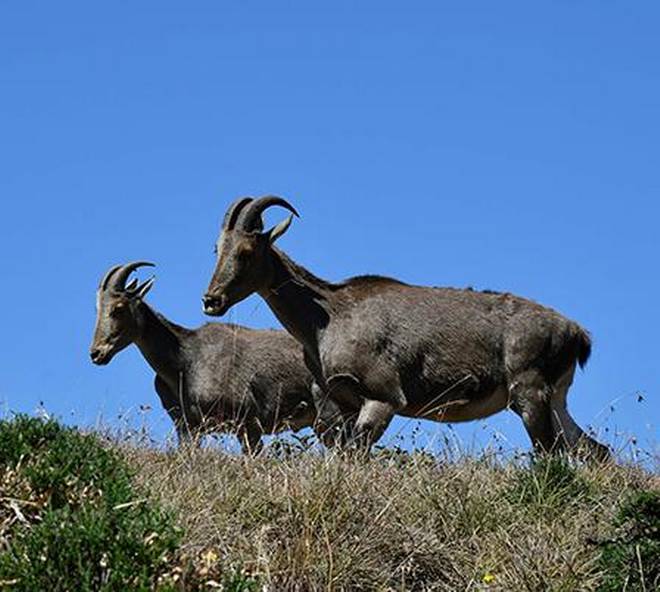Nilgiri Tahr
This is a collection of articles archived for the excellence of their content. |
Contents |
Population
2016-18, population grown by 18%
Rohan Premkumar, August 31, 2018: The Hindu

From: Rohan Premkumar, The Nilgiri tahr climbs population charts, August 31, 2018: The Hindu
The species, however, remains under threat from invasive plants
In a heartening development for conservationists, a recent census has revealed that the population of the Nilgiri tahr (an endangered mountain goat) at the Mukurthi National Park has grown by an impressive 18% in the last two years, from 480 to 568.
Tamil Nadu Forest Department officials said that a count conducted in 2016 had put the population in the national park at around 480, but a revised count in 2017 pegged it at 438. “Getting an exact figure each year is difficult, so there is always a small discrepancy in numbers. In 2018, however, there is a definite increase in the number of animals in the only pristine habitat left in the Nilgiris for the tahr,” said a Forest Department official.
The population estimation exercise, completed in May, was conducted jointly by the Forest Department and the Department of Zoology and Wildlife Biology, Government Arts College, Udhagamandalam.
B. Ramakrishnan, assistant professor in the department, said that apart from the increase in numbers, the sex ratio, too, was encouraging. “From what we have recorded, there are two adult females for every male. This indicates a viable breeding population, and hints at further population growth,” he said.
Several threats
If that is the good news, the bad news is that the population also faces several threats. Researchers point to the continuing spread of invasive species of flora, such as wattle and pine, and exotic weeds like scotch broom (Cystisus scoparius) and gorse, which end up diminishing grazing land.
“We don’t know how the consumption of exotic weeds will affect the animals. So we need a large-scale project to remove exotic plants,” said Mr. Ramakrishnan.
The rise in the animals’ population has led to a few herds migrating out of the national park, into the erstwhile Nilgiris South Forest Division.
S. Senbagapriya, Deputy Director, Mudumalai Tiger Reserve and Mukurthi National Park, said that the Forest Department was stepping up efforts to remove exotics, with wattle eliminated in over 125 hectares of Shola grasslands.
Threats

From: Aathira Perinchery, The endangered wild goat could lose approximately 60% of its habitat, starting from the 2030s, July 11, 2018: The Hindu
The antics of the sure-footed Nilgiri tahr are a treat to watch, but these endangered wild mountain goats – found only in high altitudes in India’s Western Ghats — could be losing their footing with increasing climate change. Even under moderate scenarios of future climate change, tahrs could lose approximately 60% of their habitats from the 2030s on, predict scientists in their study in Ecological Engineering, an international journal that emphasises the need for ecological restoration.
Scientists tried to predict how climate change can affect tahr habitat in the Ghats by mapping tahr distribution (using existing information and field surveys) and then using climatic factors of these locations to see where tahrs would be able to survive, given current and future climate change scenarios.
They found that tahr strongholds such as Chinnar, Eravikulam and Parambikulam in Kerala will still be stable habitats under different climate change scenarios.
However, other regions, including parts of Tamil Nadu’s Kalakkad Mundanthurai Tiger Reserve and the wildlife sanctuaries of Peppara, Neyyar, Schenduruny and Srivilliputhur, could experience severe habitat loss in future; in total, approx. 60% of tahr habitat could be lost across the Ghats from 2030s onwards. There are only around 2,500 tahrs left in the wild and their population — “small and isolated, making them vulnerable to local extinction” — shows a “decreasing” trend, as per the International Union for Conservation of Nature.
Local threat
According to senior author Jayahari K. M. of Delhi-based World Resource Institute India, the study has to be seen in the context of this identified vulnerability; the impacts of climate change may further increase the chances of local extinction, he said. The study’s findings demand a comprehensive species management plan, said co-authors Sony R.K. and Sandeep Sen of the Ashoka Trust for Research in Ecology and the Environment.
Scientists, including P. S. Easa, member of the National Board for Wildlife (who also co-authored the latest report on Kerala’s tahr populations), had drafted a tahr recovery plan in 2010. According to the report, only the Eravikulam and Mukurthi National Parks stress on tahr-centered conservation activities in their management plans. Though the recovery plan identified “conservation units” and made site-specific recommendations, how much of it has been implemented is unclear, said Dr. Easa.
“It is important that we focus our efforts on these conservation units and monitor isolated populations,” he said.